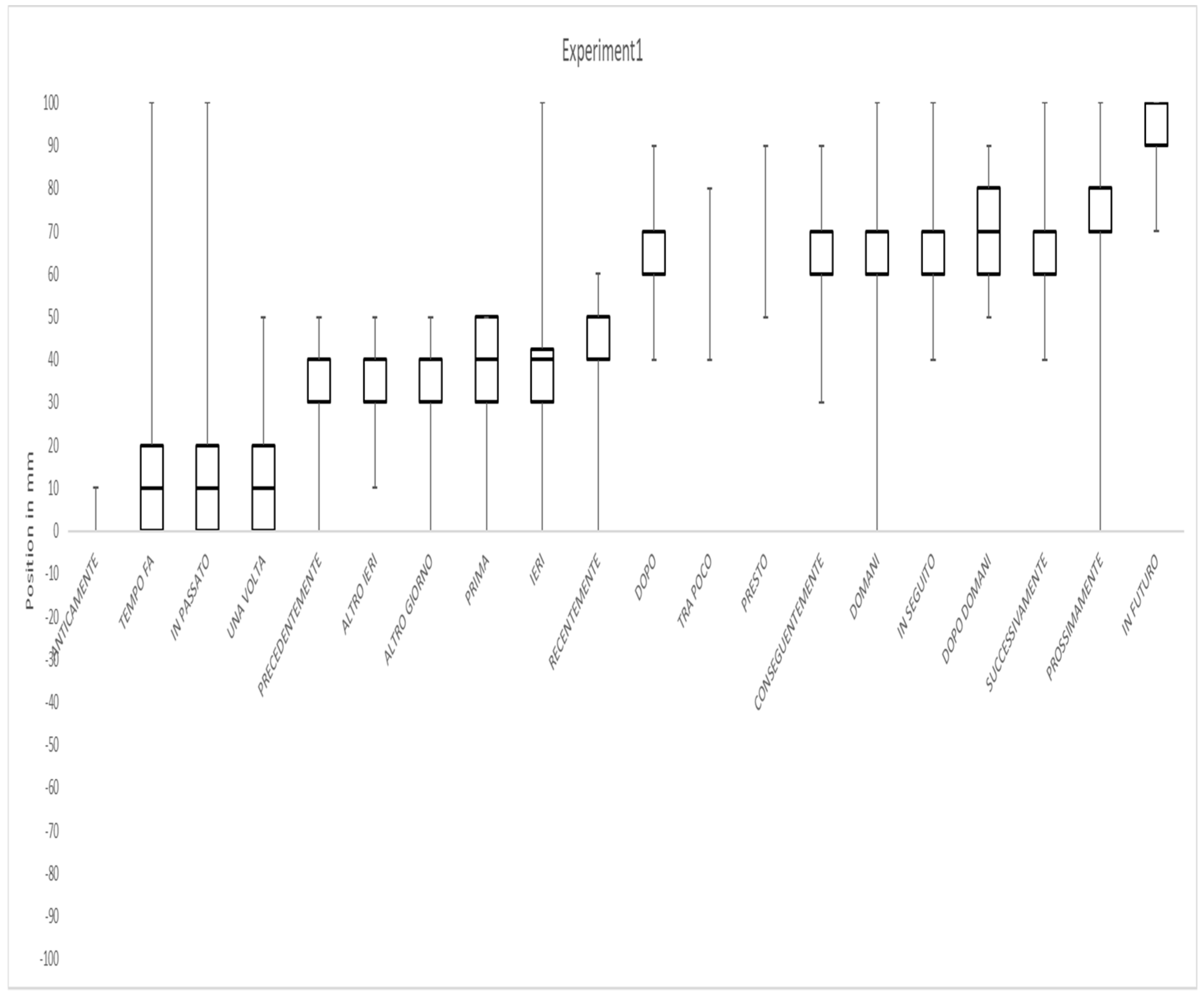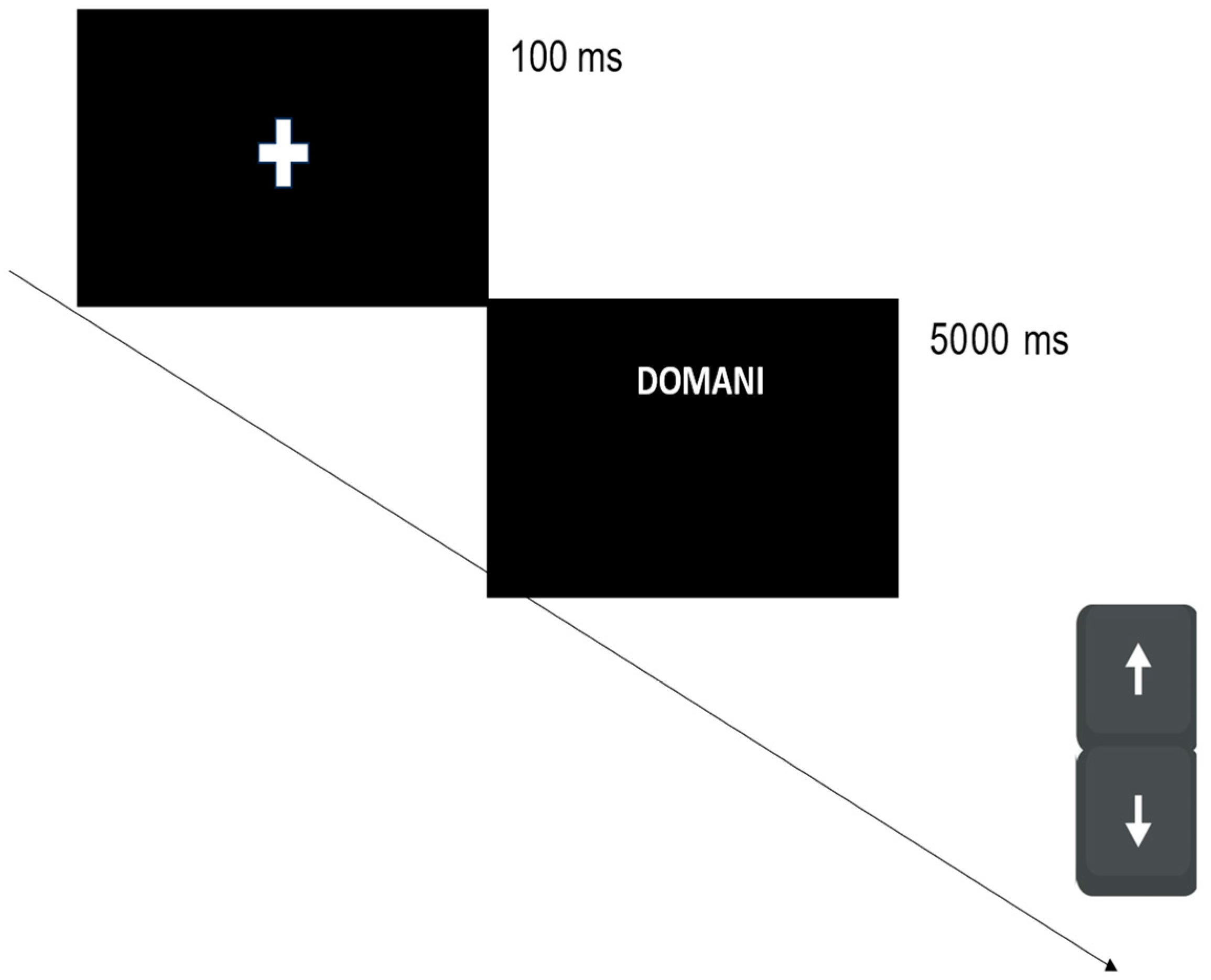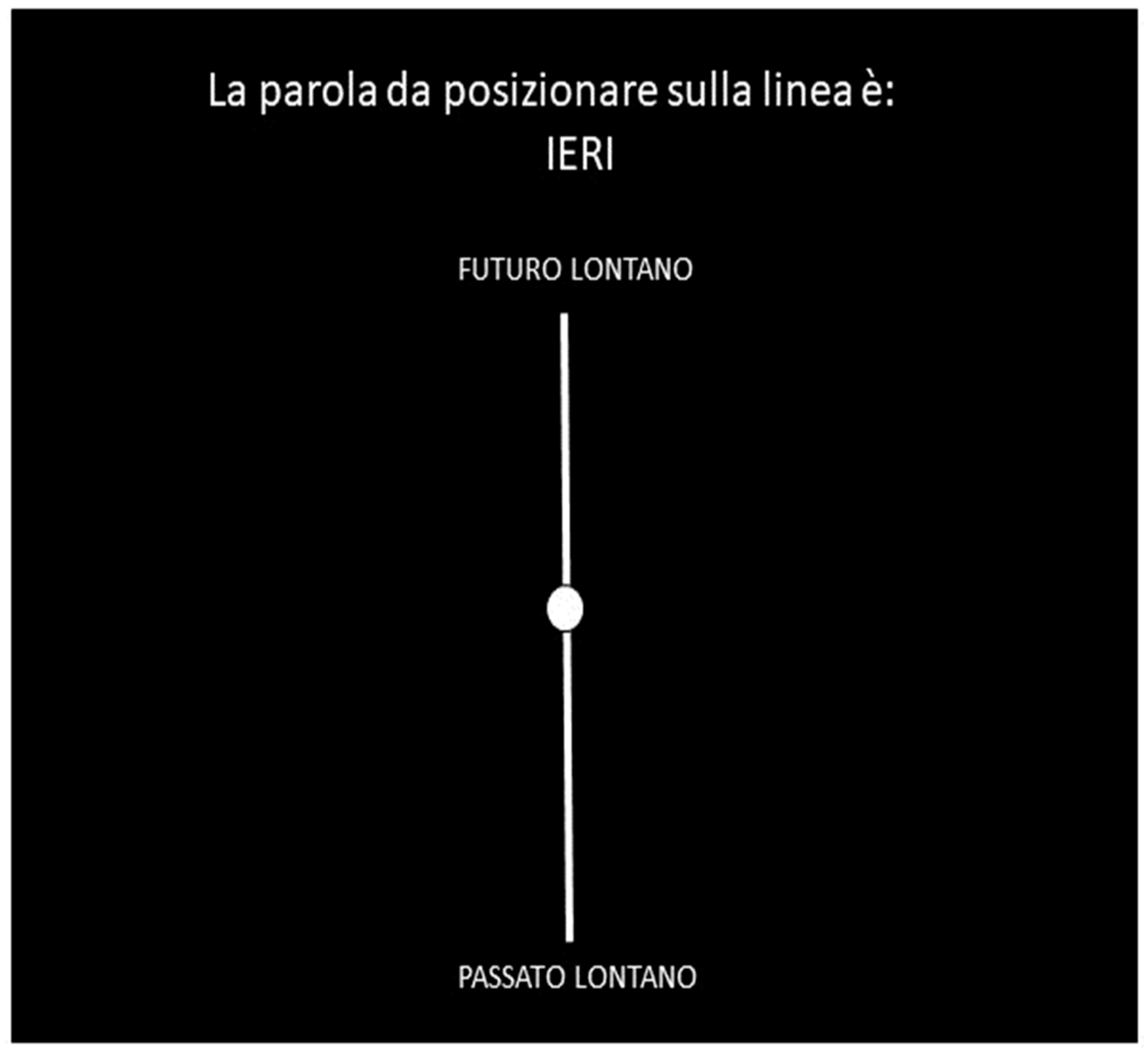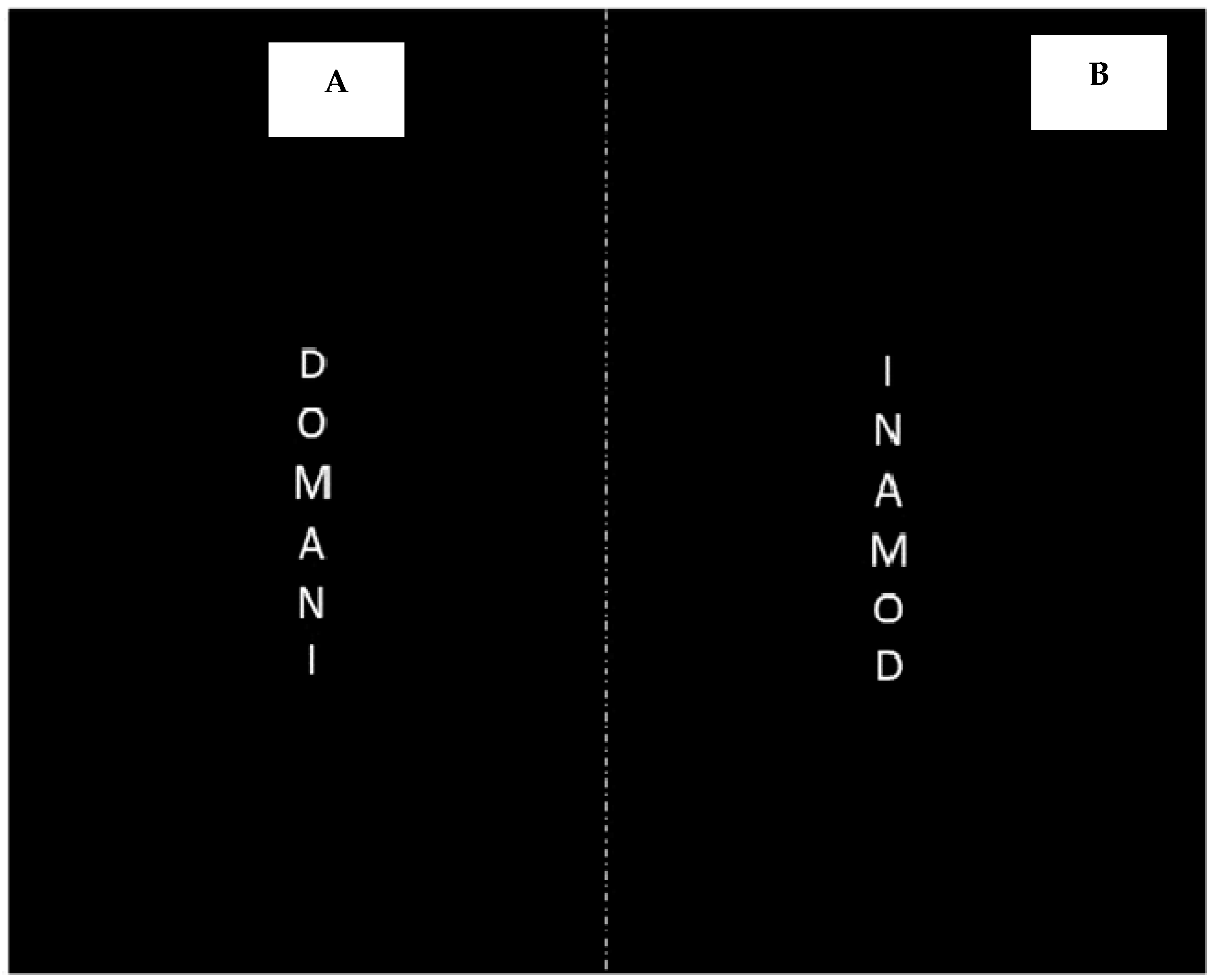Vertical Mental Timeline Is Not Influenced by VisuoSpatial Processing
Abstract
1. Introduction
1.1. Vertical Timeline
1.2. Predictions of the Present Study
1.3. The Present Study
2. Experiment 1
2.1. Materials and Methods
2.2. Results
2.3. Discussion
3. Experiment 2A
3.1. Materials and Methods
3.2. Results
3.3. Discussion
4. Experiment 2B
4.1. Materials and Methods
4.2. Results
4.3. Discussion
5. General Discussion
5.1. Vertical STEARC Effect
5.2. Vertical Visuospatial Processing Effect
5.3. Vertical Mental Timeline
5.4. The Time-to-Position Task and Its Association with the Temporal Categorization Task
5.5. Limits
6. Conclusions
Supplementary Materials
Author Contributions
Funding
Institutional Review Board Statement
Informed Consent Statement
Data Availability Statement
Acknowledgments
Conflicts of Interest
Appendix A
| PAST | Translations |
|---|---|
| Anticamente | formerly |
| Tempo fa | long ago |
| In passato | in the past |
| Una volta | once |
| Precedentemente | previously |
| L’altroieri | the day before yesterday |
| L’altrogiorno | the other day |
| Prima | before |
| Ieri | yesterday |
| Recentemente | recently |
| FUTURE | |
| Dopo | after |
| Trapoco | soon |
| Presto | early |
| Conseguentemente | consequently |
| Domani | tomorrow |
| In seguito | later |
| Dopodomani | the day after tomorrow |
| Successivamente | subsequently |
| Prossimamente | next |
| In futuro | in the future |


References
- Winter, B.; Marghetis, T.; Matlock, T. Of magnitude and metaphors: Explaining cognitive interactions between space, time, and number. Cortex 2015, 64, 209–224. [Google Scholar] [CrossRef]
- von Sobbe, L.; Scheifele, E.; Maienborn, C.; Ulrich, R. The space-time congruency effect: A meta-analysis. Cogn. Sci. 2019, 43, e12709. [Google Scholar] [CrossRef]
- Walsh, V. A Theory of Magnitude: Common cortical metrics of time, space and quantity. Trends Cogn. Sci. 2003, 7, 483–488. [Google Scholar] [CrossRef]
- Bueti, D.; Walsh, V. The parietal cortex and the representation of time, space, number and other magnitudes. Phil. Trans. R. Soc. Lond. B Biol. Sci. 2009, 364, 1831–1840. [Google Scholar] [CrossRef]
- Oliveri, M.; Koch, G.; Caltagirone, C. Spatial-temporal interactions in the human brain. Exp. Brain Res. 2009, 195, 489–497. [Google Scholar] [CrossRef]
- Dehaene, S.; Bossini, S.; Giraux, P. The mental representation of parity and number magnitude. J. Exp. Psychol. Gen. 1993, 122, 371–396. [Google Scholar] [CrossRef]
- Ishihara, M.; Keller, P.E.; Rossetti, Y.; Prinz, W. Horizontal spatial representation of time: Evidence for the STEARC effect. Cortex 2008, 44, 454–461. [Google Scholar] [CrossRef] [PubMed]
- Bonato, M.; Zorzi, M.; Umiltà, C. When time is space: Evidence for a mental time line. Neurosci. Biobehav. Rev. 2012, 36, 2257–2273. [Google Scholar] [CrossRef] [PubMed]
- Santiago, J.; Lupiáñez, J.; Perez, E.; Funes, M.J. Time (also) flies from left to right. Psychon. Bull. Rev. 2007, 14, 512–516. [Google Scholar] [CrossRef] [PubMed]
- Arzy, S.; Collette, S.; Ionta, S.; Fornari, E.; Blanke, O. Subjective mental time line: The functional architecture of projecting the self to past and future. Eur. J. Neurosci. 2009, 30, 2009–2017. [Google Scholar] [CrossRef] [PubMed]
- Arzy, S.; Adi-Japha, E.; Blanke, O. The mental time line: An analogue of the mental number line in the mapping of life events. Conscious. Cogn. 2009, 18, 781–785. [Google Scholar] [CrossRef] [PubMed]
- Boroditsky, L. Does language shape thought? English and Mandarin speakers’ conceptions of time. Cogn. Psychol. 2001, 43, 1–22. [Google Scholar] [CrossRef] [PubMed]
- Fabbri, M.; Cancellieri, J.; Natale, V. The A Theory of Magnitude (ATOM) model in temporal perception and reproduction tasks. Acta Psychol. 2012, 139, 111–123. [Google Scholar] [CrossRef] [PubMed]
- Fabbri, M.; Cellini, N.; Martoni, M.; Tonetti, L.; Natale, V. The mechanisms of space-time association: Comparing motor and perceptual contributions in time reproduction. Cogn. Sci. 2013, 37, 1228–1250. [Google Scholar] [CrossRef] [PubMed]
- Hartmann, M.; Mast, F.W. Moving along the mental time line influences the processing of future related words. Conscious. Cogn. 2012, 21, 1558–1562. [Google Scholar] [CrossRef] [PubMed]
- Vallesi, A.; Binns, M.A.; Shallice, T. An effect of spatial-temporal association of response codes: Understanding the cognitive representations of time. Cognition 2008, 107, 501–527. [Google Scholar] [CrossRef]
- Weger, U.; Pratt, J. Time flies like an arrow: Shifting spatial attention in response to adverbs of time. Psychon. Bull. Rev. 2008, 15, 426–430. [Google Scholar] [CrossRef]
- Ouellet, M.; Santiago, J.; Israeli, Z.; Gabay, S. Is the future the right time? Exp. Psychol. 2010, 57, 308–314. [Google Scholar] [CrossRef]
- Pitt, B.; Casasanto, D. The correlations in experience principle: How cultures shapes concepts of time and number. J. Exp. Psychol. Gen. 2020, 149, 1048–1070. [Google Scholar] [CrossRef]
- Fuhrman, O.; Boroditsky, L. Cross-cultural differences in mental representations of time: Evidence from an implicit nonlinguistic task. Cogn. Sci. 2010, 34, 1430–1451. [Google Scholar] [CrossRef]
- Tversky, B.; Kugelmass, S.; Winter, A. Cross-cultural and developmental trends in graphic productions. Cogn. Psychol. 1991, 23, 515–557. [Google Scholar] [CrossRef]
- Torralbo, A.; Santiago, J.; Lupiáñez, J. Flexible conceptual projection of time onto spatial frames of reference. Cogn. Sci. 2006, 30, 745–757. [Google Scholar] [CrossRef]
- Fabbri, M.; Cellini, N.; Martoni, M.; Tonetti, L.; Natale, V. Perceptual and motor congruency effects in time-space association. Atten. Percept. Psychophys. 2013, 75, 1840–1851. [Google Scholar] [CrossRef]
- Di Bono, M.G.; Casarotti, M.; Gava, L.; Umiltà, C.; Zorzi, M. Priming the mental time line. J. Exp. Psychol. Hum. Percept. Perform. 2012, 38, 838–842. [Google Scholar] [CrossRef] [PubMed]
- Vicario, C.M.; Pecoraro, P.; Turriziani, P.; Koch, G.; Caltagirone, C.; Oliveri, M. Relativistic compression and expansion of experimental time in the left and right space. PLoS ONE 2008, 3, e1716. [Google Scholar] [CrossRef]
- Vicario, C.M.; Rappo, G.; Pepi, A.M.; Oliveri, M. Timing flickers across sensory modalities. Perception 2009, 38, 1144–1151. [Google Scholar] [CrossRef]
- Beracci, A.; Santiago, J.; Fabbri, M. The categorical use of a continuous time representation. Psychol. Res. 2022, 86, 1015–1028. [Google Scholar] [CrossRef]
- Grasso, C.L.; Ziegler, J.C.; Coull, J.T.; Montant, M. Embodied time: Effect of reading expertise on the spatial representation of past and future. PLoS ONE 2022, 17, e0276273. [Google Scholar] [CrossRef]
- Ariel, R.; Al-Harty, I.S.; Was, C.A.; Dunlosky, J. Habitual reading biases in the allocation of study time. Psychon. Bull. Rev. 2011, 18, 1015–1021. [Google Scholar] [CrossRef] [PubMed]
- Stocker, K.; Hartmann, M.; Martarelli, C.S.; Mast, F.W. Eye movements reveal mental looking through time. Cogn. Sci. 2016, 40, 1648–1670. [Google Scholar] [CrossRef] [PubMed]
- Beracci, A.; Fabbri, M. Past on the ground floor and future in the attic: The vertical mental timeline. J. Exp. Psychol. Hum. Percept. Perform. 2022, 48, 380–399. [Google Scholar] [CrossRef]
- Beracci, A.; Rescott, M.L.; Natale, V.; Fabbri, M. The vertical space-time association. Q. J. Exp. Psychol. 2022, 75, 1674–1693. [Google Scholar] [CrossRef]
- Bergen, B.K.; Chan Lau, T.T. Writing direction affects how people map space onto time. Front. Psychol. 2012, 3, 109. [Google Scholar] [CrossRef] [PubMed]
- Boroditsky, L.; Furhman, O.; McCormik, K. Do English and Mandarin speakers think about time differently? Cognition 2011, 118, 123–129. [Google Scholar] [CrossRef]
- Chen, J.Y. Do Chinese and English speakers think about time differently? Failure of replicating Boroditsky (2001). Cognition 2007, 104, 427–436. [Google Scholar] [CrossRef]
- Dalmaso, M.; Schnapper, Y.; Vicovaro, M. When time stands upright: STEARC effects along the vertical axis. Psychol. Res. 2023, 87, 894–918. [Google Scholar] [CrossRef]
- Fuhrman, O.; McCormick, K.; Chen, E.; Jiang, H.; Shu, D.; Mao, S.; Boroditsky, L. How linguistic and cultural forces shape conceptions of time: English and Mandarin time in 3D. Cogn. Sci. 2011, 35, 1305–1328. [Google Scholar] [CrossRef]
- Gu, Y.-Y.; Zhang, Z.-Y. The horizontal and the vertical mental time line in Chinese context. Acta Psychol. Sin. 2012, 44, 1015–1024. [Google Scholar] [CrossRef]
- Leone, M.J.; Salles, A.; Pulver, A.; Golombek, D.A.; Sigman, A. Time drawing: Spatial representation of temporal concepts. Conscious. Cogn. 2018, 59, 10–25. [Google Scholar] [CrossRef] [PubMed]
- Miles, L.K.; Tan, L.; Noble, G.D.; Lumsden, J.; Macrae, C.N. Can a mind have two time lines? Exploring space-time mapping in Mandarin and English speakers. Psychon. Bull. Rev. 2011, 18, 598–604. [Google Scholar] [CrossRef]
- Ruiz-Fernández, S.; Lachmair, M.; Rahona, J.J. Human mental representation of time in the vertical space. In Proceedings of the 6th International Congress of Medicine in Space and Extreme Environments (ICMS), Berlin, Germany, 16–19 September 2014. [Google Scholar]
- Topić, V.; Stojić, S.; Domijan, D. An implicit task reveals space-time associations along vertical and diagonal axes. Psychol. Res. 2022, 86, 1252–1261. [Google Scholar] [CrossRef]
- Woodin, G.; Winter, B. Placing abstract concepts in space: Quantity, time and emotional valence. Front. Psychol. 2018, 9, 2169. [Google Scholar] [CrossRef]
- Lakoff, G.; Johnson, M. Philosophy in the Flesh: The Embodied Mind and Its Challenge to Western Thought; Basic Books: New York, NY, USA, 1999. [Google Scholar]
- Myachykov, A.; Scheepers, C.; Fischer, M.H.; Kessler, K. TEST: A tropic, embodied, and situated theory of cognition. Trends Cogn. Sci. 2014, 6, 442–460. [Google Scholar] [CrossRef]
- Fischer, M.H. A hierarchical view of grounded, embodied, and situated numerical cognition. Cogn. Process. 2012, 13, 161–164. [Google Scholar] [CrossRef]
- Hong, T.; He, X.; Tillman, R.; Zhao, X.; Deng, Y. The vertical and horizontal spatial-temporal conceptual metaphor representation of Chinese temporal words. Psychology 2017, 8, 1679–1692. [Google Scholar] [CrossRef][Green Version]
- Casasanto, D.; Bottini, R. Mirror reading can reverse the flow of time. J. Exp. Psychol. Gen. 2014, 143, 473–479. [Google Scholar] [CrossRef]
- Kong, F.; You, X. Space-time compatibility effects in the auditory modality. Exp. Psychol. 2012, 59, 82–87. [Google Scholar] [CrossRef]
- Proctor, R.W.; Cho, Y.S. Polarity correspondence: A general principle for performance of speeded binary classification task. Psychol. Bull. 2006, 132, 416–442. [Google Scholar] [CrossRef] [PubMed]
- Riemer, M.; Diersch, N.; Bublatzky, F.; Wolbers, T. Space, time, and numbers in the right posterior parietal cortex: Differences between response code associations and congruency effects. NeuroImage 2016, 129, 72–79. [Google Scholar] [CrossRef] [PubMed]
- Vallesi, A.; McIntosh, A.R.; Struss, D.T. How time modulates spatial responses. Cortex 2011, 47, 148–156. [Google Scholar] [CrossRef] [PubMed]
- Gevers, W.; Lammertyn, J.; Notebaert, W.; Verguts, T.; Fias, W. Automatic response activation of implicit spatial information: Evidence from the SNARC effect. Acta Psychol. 2006, 122, 221–233. [Google Scholar] [CrossRef]
- Ito, Y.; Hatta, T. Spatial structure of quantitative representation of numbers: Evidence from the SNARC effect. Mem. Cogn. 2004, 32, 662–673. [Google Scholar] [CrossRef] [PubMed]
- Rusconi, E.; Kwan, B.; Giordano, B.L.; Umiltà, C.; Butterworth, B. Spatial representation of pitch height: The SMARC effect. Cognition 2006, 99, 113–129. [Google Scholar] [CrossRef] [PubMed]
- Vu, K.P.L.; Proctor, R.W.; Pick, D.F. Vertical versus horizontal spatial compatibility: Right-left prevalence with bimanual responses. Psychol. Res. 2000, 64, 25–40. [Google Scholar] [CrossRef]
- Erdfelder, E.; Faul, F.; Buchner, A. GPOWER: A general power analysis program. Behav. Res. Meth. Instrum. Comput. 1996, 28, 1–11. [Google Scholar] [CrossRef]
- Cohen, J. Statistical Power Analysis for the Behavioral Sciences, 2nd ed.; Lawrence Erlbaum Associates Publishers: Hillsdale, NJ, USA, 1988. [Google Scholar]
- Oldfield, R.C. The assessment analysis of handedness: The Edinburgh Inventory. Neuropsychologia 1971, 9, 97–113. [Google Scholar] [CrossRef]
- Schneider, W.; Eschman, A.; Zuccolotto, A. E-Prime User’s Guide; Psychology Software Tools Inc.: Pittsburgh, PA, USA, 2012. [Google Scholar]
- Lorch, R.F.; Myers, J.L. Regression analyses of repeated measures data in cognitive research. J. Exp. Psychol. Learn. Mem. Cogn. 1990, 16, 149–157. [Google Scholar] [CrossRef]
- Santiago, J.; Lakens, D. Can conceptual congruency effect between number, time, and space be accounted for by polarity correspondence? Acta Psychol. 2015, 156, 179–191. [Google Scholar] [CrossRef]
- Núñez, R.; Cooperrider, K. The tangle of space and time in human cognition. Trends Cogn. Sci. 2013, 17, 220–229. [Google Scholar] [CrossRef]
- Hommel, B. The relationship between stimulus processing and response selection in the Simon task: Evidence for a temporal overlap. Psychol. Rep. 1993, 55, 280–290. [Google Scholar] [CrossRef]
- Ridderinkhof, K.R. Activation and suppression in conflict task: Empirical clarification through distributional analyses. In Attention and Performance XIX: Common Mechanisms in Perception and Action; Prinz, W., Hommel, B., Eds.; Oxford University Press: Oxford, UK, 2002; pp. 494–519. [Google Scholar]
- Gevers, W.; Caessens, B.; Fias, W. Towards a common processing architecture underlying Simon and SNARC effects. Eur. J. Cogn. Psychol. 2005, 17, 659–673. [Google Scholar] [CrossRef]
- Cappelletti, M.; Freeman, E.D.; Cipolotti, L. The middle house or the middle floor: Bisecting horizontal and vertical mental number lines in neglect. Neuropsychologia 2007, 45, 2989–3000. [Google Scholar] [CrossRef] [PubMed]
- Fabbri, M. Spatial congruency between stimulus presentation and response key arrangements in arithmetic fact retrieval. Am. J. Psychol. 2011, 124, 325–340. [Google Scholar] [CrossRef] [PubMed]
- Fabbri, M. Finger counting habits and spatial-numerical association in horizontal and vertical orientation. J. Cogn. Cult. 2013, 13, 95–110. [Google Scholar] [CrossRef]
- Shaki, S.; Fischer, M.H. Multiple spatial mappings in numerical cognition. J. Exp. Psychol. Hum Percept. Perform. 2012, 38, 804–809. [Google Scholar] [CrossRef] [PubMed]
- Lakoff, G. Women, Fire, and Dangerous Thing: What Categories Reveal About the Mind; University of Chicago Press: Chicago, IL, USA, 1987. [Google Scholar]
- Dalmaso, M.; Vicovaro, M. Evidence of SQUARC and distance effects in a weight comparison task. Cogn. Process. 2019, 20, 163–173. [Google Scholar] [CrossRef]
- van Dijck, J.-P.; Fias, W. A working memory account for spatial-numerical associations. Cognition 2011, 119, 114–119. [Google Scholar] [CrossRef]
- Abrahamse, E.; van Dijck, J.-P.; Majerus, S.; Fias, W. Finding the answer in space: The mental whiteboard hypothesis on serial order in working memory. Front. Hum. Neurosci. 2014, 8, 932. [Google Scholar] [CrossRef]
- Ginsburg, V.; van Dijck, J.-P.; Previtali, P.; Fias, W.; Gevers, W. The impact of verbal working memory on number-space associations. J. Exp. Psychol. Learn. Mem. Cogn. 2014, 40, 976–986. [Google Scholar] [CrossRef]



| RTs | Down Key | Up Key | ||||
|---|---|---|---|---|---|---|
| Bottom | Center | Top | Bottom | Center | Top | |
| Past words | 1097 | 1031 | 1116 | 1208 | 1170 | 1208 |
| (281) | (263) | (262) | (275) | (308) | (297) | |
| Future words | 1222 | 1171 | 1240 | 1118 | 1001 | 1090 |
| (310) | (294) | (301) | (261) | (264) | (282) | |
| NEs | Down Key | Up Key | ||||
| Bottom | Center | Top | Bottom | Center | Top | |
| Past words | 3.15 | 4.46 | 5.48 | 6.07 | 5.65 | 5.48 |
| (3.51) | (4.85) | (5.33) | (5.86) | (6.03) | (5.41) | |
| Future words | 7.02 | 6.19 | 6.49 | 7.80 | 4.11 | 3.87 |
| (8.38) | (6.18) | (6.89) | (9.62) | (4.49) | (4.39) | |
| Time-to-Position Tsk | N | Mean-Adjusted R2 Fit Model | Mean b Coefficient Fit Model | Regression Analysis | N | Mean-Adjusted R2 | Mean b Coefficient | Direction and Magnitude of Effect |
|---|---|---|---|---|---|---|---|---|
| Low deviators | 12 | 0.83 | +3.84 | STEARC effect | 26 | 0.35 | −42.99 | −583 ms |
| (0.08) | (0.60) | (0.12) | (20.11) | (300 ms) | ||||
| Middle deviators | 29 | 0.81 | +4.16 | No STEARC effect | 27 | 0.03 | −2.09 | −5.00 ms |
| (0.12) | (0.79) | (0.06) | (15.79) | (215 ms) | ||||
| High deviators | 15 | 0.74 | +4.31 | Reversed STEARC effect | 3 | 0.20 | +28.09 | +332 ms |
| (0.19) | (0.95) | (0.06) | (14.17) | (160 ms) |
| Experiment 2A | Experiment 2B | |||||||||||
|---|---|---|---|---|---|---|---|---|---|---|---|---|
| RTs | Down Key | Up Key | Down Key | Up Key | ||||||||
| Bottom | Center | Top | Bottom | Center | Top | Bottom | Center | Top | Bottom | Center | Top | |
| Past words | 1233 | 1189 | 1291 | 1392 | 1309 | 1388 | 1441 | 1330 | 1375 | 1575 | 1457 | 1540 |
| (310) | (342) | (307) | (335) | (370) | (373) | (322) | (294) | (342) | (290) | (291) | (318) | |
| Future words | 1341 | 1246 | 1332 | 1250 | 1141 | 1243 | 1580 | 1391 | 1521 | 1445 | 1267 | 1367 |
| (338) | (356) | (331) | (280) | (330) | (304) | (334) | (285) | (318) | (320) | (318) | (290) | |
| Experiment 2A | Experiment 2B | |||||||||||
| NEs | Down Key | Up Key | Down Key | Up Key | ||||||||
| Bottom | Center | Top | Bottom | Center | Top | Bottom | Center | Top | Bottom | Center | Top | |
| Past words | 7.14 | 6.63 | 5.62 | 4.94 | 5.54 | 5.96 | 4.47 | 3.86 | 5.00 | 5.45 | 6.51 | 6.82 |
| (12.02) | (11.04) | (12.50) | (5.21) | (4.54) | (6.97) | (6.74) | (5.84) | (6.76) | (6.35) | (8.35) | (7.77) | |
| Future words | 5.22 | 5.86 | 6.80 | 8.15 | 6.44 | 6.03 | 9.39 | 6.97 | 5.98 | 6.14 | 5.15 | 4.47 |
| (5.74) | (6.43) | (6.97) | (13.03) | (11.06) | (11.82) | (10.74) | (8.16) | (8.61) | (7.94) | (6.41) | (5.88) | |
| Experiment 2A | ||||||||
|---|---|---|---|---|---|---|---|---|
| Time-to-Position Task | N | Mean-Adjusted R2 Fit Model | Mean b Coefficient Fit Model | Regression Analysis | N | Mean-adjusted R2 | Mean b Coefficient | Direction and Magnitude of Effect |
| Low deviators | 7 | 0.85 | +3.73 | STEARC effect | 15 | 0.33 | −53.30 | −678 ms |
| (0.05) | (0.41) | (0.14) | (38.65) | (407 ms) | ||||
| Middle deviators | 25 | 0.79 | +4.11 | No STEARC effect | 23 | 0.0001 | −2.71 | −24 ms |
| (0.13) | (0.68) | (0.05) | (14.91) | (197 ms) | ||||
| High deviators | 10 | 0.79 | +4.19 | Reversed STEARC effect | 4 | 0.34 | +30.62 | +369 ms |
| (0.10) | (0.67) | (0.11) | (12.87) | (219 ms) | ||||
| Experiment 2B | ||||||||
| Time-to-Position task | N | Mean-adjusted R2 Fit model | Mean b coefficient fit model | Regression Analysis | N | Mean-adjusted R2 | Mean b coefficient | Direction and Magnitude of effect |
| Low deviators | 11 | 0.80 | +3.94 | STEARC effect | 17 | 0.43 | −72.42 | −973 ms |
| (0.10) | (0.88) | (0.12) | (24.81) | (371 ms) | ||||
| Middle deviators | 23 | 0.81 | +4.02 | No STEARC effect | 19 | 0.02 | −7.02 | −128 ms |
| (0.09) | (0.60) | (0.06) | (14.07) | (261 ms) | ||||
| High deviators | 10 | 0.76 | +4.19 | Reversed STEARC effect | 8 | 0.46 | 66.10 | +831 ms |
| (0.11) | (0.71) | (0.17) | (29.79) | (373 ms) | ||||
Disclaimer/Publisher’s Note: The statements, opinions and data contained in all publications are solely those of the individual author(s) and contributor(s) and not of MDPI and/or the editor(s). MDPI and/or the editor(s) disclaim responsibility for any injury to people or property resulting from any ideas, methods, instructions or products referred to in the content. |
© 2024 by the authors. Licensee MDPI, Basel, Switzerland. This article is an open access article distributed under the terms and conditions of the Creative Commons Attribution (CC BY) license (https://creativecommons.org/licenses/by/4.0/).
Share and Cite
Beracci, A.; Fabbri, M. Vertical Mental Timeline Is Not Influenced by VisuoSpatial Processing. Brain Sci. 2024, 14, 184. https://doi.org/10.3390/brainsci14020184
Beracci A, Fabbri M. Vertical Mental Timeline Is Not Influenced by VisuoSpatial Processing. Brain Sciences. 2024; 14(2):184. https://doi.org/10.3390/brainsci14020184
Chicago/Turabian StyleBeracci, Alessia, and Marco Fabbri. 2024. "Vertical Mental Timeline Is Not Influenced by VisuoSpatial Processing" Brain Sciences 14, no. 2: 184. https://doi.org/10.3390/brainsci14020184
APA StyleBeracci, A., & Fabbri, M. (2024). Vertical Mental Timeline Is Not Influenced by VisuoSpatial Processing. Brain Sciences, 14(2), 184. https://doi.org/10.3390/brainsci14020184






